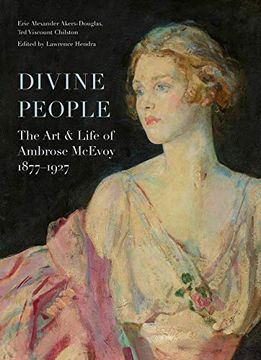Reseña del libro "Divine People: The art and Life of Ambrose Mcevoy (1877-1927) (en Inglés)"
Ambrose McEvoy was one of the most modern and daring English society portrait painters of the early 20th century. His quick, confident style of painting drew the attention of many leading society figures, from Winston Churchill to Lady Diana Cooper, and in particular subjects who craved something beyond a simple 'likeness' in paint. Despite his success, when McEvoy died unexpectedly at the peak of his career in 1927, his name was soon forgotten. Divine People is the first major written study of McEvoy's life and work and aims to firmly place this long-neglected artist back into the canon of 20th-century British art. Ambrose McEvoy (1877-1927) was a household name by 1915, with prominent socialites and debutantes vying for sittings in his Grosvenor Road studio. His patrons - typically young, well-known beauties - were dazzled not only by his remarkable ability to capture their character, but also his working methods, which one spectator described as an 'awe-inspiring sight'. McEvoy would illuminate his subject using electric lights, switching between different coloured bulbs until he reached the level and colour of light he desired. This 'Hollywood' look, with his glamourous subjects lit from below as if caught mid-speech on stage, is what he soon became best known for. McEvoy had studied at the Slade School of Fine Art on the recommendation of James Abbott McNeill Whistler, and soon after established himself as a talented painter of portraits and interior scenes. He exhibited his first work at the New English Art Club in 1901 and subsequently attracted the attention of wealthy patrons and collectors. His first major commission came in 1906, for two large religious pictures for the Long Tower Church in Londonderry, where they remain to this day. After a period spent in Dieppe with Walter Sickert in 1909 McEvoy's style began to change and his handling became looser and more confident with bolder use of colour. In 1915 he firmly established his position as a portrait painter following the exhibition of his work Madame at the National Portrait Society. '[Madame] holds you spellbound from the moment you enter the gallery,' wrote one critic. Two of his earliest admirers were Consuelo, Duchess of Marlborough and Lady Diana Cooper, who sat for their portraits in 1917 and 1918 respectively. In the early 1920s McEvoy also made several trips to New York, where the famous art dealer and tastemaker Joseph Duveen was busy promoting his work. It was during these years he painted some of his best-known works including remarkable watercolours of 'wild-child' Lois Sturt and a portrait of James Ramsay MacDonald. In 1927, at the very peak of his career, McEvoy was tragically struck down with pneumonia and died on 4 January. Many of McEvoy's friends and contemporaries including Augustus and Gwen John, William Rothenstein and William Orpen have become familiar names to British art enthusiasts, but McEvoy has remained on the side-lines. This is partly due to the fact that many of his most accomplished works have remained tucked away in private collections or left languishing in museum stores, however, it is also due to the absence of any reliable literature on his life and work. This publication hopes to restore him to his rightful place. Written in the early 1970s by Erik Akers-Douglas, 3rd Viscount Chilston (1910-1986), the original manuscript - of which only one copy was produced - was lost soon after it was submitted to a publisher in 1975. After several years of legal wrangling, Chilston decided to type a second copy and it was resubmitted to his agent. Chilston died the following month and the manuscript was never published. It was recently rediscovered by Philip Mould& Company and edited by Lawrence Hendra.

